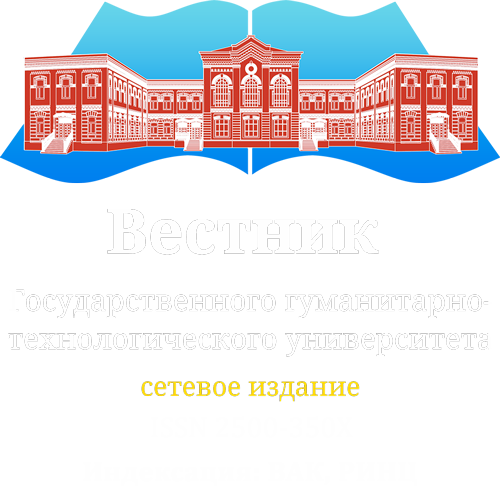Вестник Государственного гуманитарно-технологического университета. 2022. № 1. С. 68‒73. ISSN 2500-350X (online)
Vestnik of State University of Humanities and Technology. 2022. no 1. P. 68‒73. ISSN 2500-350X (online)
Научная статья УДК 373.2
💾 ИСПОЛЬЗОВАНИЕ ИНТЕРАКТИВНЫХ ИГРОВЫХ ТЕХНОЛОГИЙ ДЛЯ РАЗВИТИЯ РЕЧИ ДЕТЕЙ ДОШКОЛЬНОГО ВОЗРАСТА Татьяна Васильевна Тимохина1, Ольга Александровна Галстян2 1,2Государственный гуманитарно-технологический университет, Орехово-Зуево, Россия 1timohina.tv@mail.ru, https://orcid.org/0000-0003-1255-5073 2o-galstyan@yandex.ru, https://orcid.org/0000-0002-3371-2181
Аннотация. В данной статье рассмотрены различные аспекты использования интерактивных игровых технологий для развития детей как необходимый компонент подготовки к школьному обучению в условиях детского сада. Игровая деятельность рассмотрена с позиции одного из эффективных приемов формирования системы знаний, умений и навыков ребенка. Изучены теоретические основы использования интерактивных игровых технологий для стимулирования речи дошкольников с нормотипичным развитием и особыми образовательными потребностями. Выявлено, что интерактивные игровые технологии являются одним из самых результативных педагогических методов активного обучения, возможного к реализации в неформальной, нерегламентированной свободной деятельности ребенка.
Особым вектором рассмотрения являются условия образования, когда интерактивные технологии используются как возможность эффективно реализовать образовательную программу в соответствии с ФГОС с детьми, испытывающими трудности в речевом развитии. Интерактивная игровая технология, влияя на активные формы поведения ребенка, обладает социализирующим эффектом.
В настоящей статье изучены психолого-педагогические основы речевого развития детей, что позволяет наиболее эффективно построить стратегию использования интерактивных игровых технологий в речевом развитии. Определена структура создания интерактивных игровых технологий с детьми в условиях дошкольной группы, которая основана на взаимосвязи пяти основных компонентов: интерактивной задачи, игровой задачи, игровых действий, правил игры, результата (подведения итогов). Сделан вывод об использовании интерактивных игровых технологий как эффективного направления развития ребенка, состоящего из групп методов и приемов активного обучения.
Ключевые слова: игровая технология, интерактивная технология, дети, развитие речи, дошкольный возраст, воспитание, обучение
Для цитирования: Тимохина Т.В., Галстян О.А. Использование интерактивных игровых технологий для развития речи детей дошкольного возраста // Вестник Государственного гуманитарно-технологического университета. 2022. № 1. С. 68‒73.
SUMMARY
THE USE OF INTERACTIVE GAMING TECHNOLOGIES FOR THE SPEECH DEVELOPMENT OF PRESCHOOL CHILDREN
Tatiana V. Timokhina1, Olga A. Galstyan2
1,2State University of Humanities and Technology, Orekhovo-Zuevo, Russia
1timohina.tv@mail.ru, https://orcid.org/0000-0003-1255-5073
2o-galstyan@yandex.ru, https://orcid.org/0000-0002-3371-2181
Abstract. This article considers various aspects of the use of interactive gaming technologies for the development of children as a necessary component of preparation for schooling in a kindergarten. Game activity is considered from the position of one of the effective methods of forming a system of knowledge, skills and abilities of a child. The theoretical foundations of the use of interactive gaming technologies to stimulate the speech of preschoolers with normotypical development and special educational needs have been studied. It was revealed that interactive gaming technologies are one of the most effective pedagogical methods of active learning, which can be implemented in the informal, unregulated free activities of the child.
A special vector of consideration is the conditions of education, when interactive technologies are used as an opportunity to effectively implement an educational program in accordance with the Federal State Educational Standard with children who experience difficulties in speech development. Interactive game technology, influencing the active forms of child behavior, has a socializing effect.
In this article, the psychological and pedagogical foundations of the speech development of children are studied, which makes it possible to most effectively build a strategy for using interactive gaming technologies in speech development. The structure of creating interactive gaming technologies with children in a preschool group is determined, which is based on the relationship of five main components: interactive task, game task, game actions, game rules, result (summing up). The conclusion on the use of interactive gaming technologies as an effective direction for the child’s development, consisting of groups of methods and techniques of active learning is made.
Key words: gaming technology, interactive technology, children, speech development, preschool age, upbringing, education
For citation: Timokhina T.V., Galstyan O.A. The use of interactive gaming technologies for the speech development of preschool children // Vestnik of State University of Humanities and Technology. 2022. no 1. P. 68‒73.
Информация об авторах
Т.В. Тимохина — доктор педагогических наук, профессор кафедры теории и методики начального и дошкольного образования Государственного гуманитарно-технологического университета.
О.А. Галстян — кандидат психологических наук, доцент, заведующий кафедрой психологии и социальной педагогики Государственного гуманитарно-технологического университета.
Information about the authors
T.V. Timokhina — Doctor of Pedagogy, Professor of the Chair of Theory and Methodology of Primary and Preschool Education, State University of Humanities and Technology.
O.A. Galstyan — Ph.D. of Psychology, Head of the Chair of Psychology and Social Pedagogy, State University of Humanities and Technology.
Статья поступила в редакцию 30.01.2022; одобрена после рецензирования 21.02.2022; принята к публикации 15.03.2022.
The article was submitted 30.01.2022; approved after reviewing 21.02.2022; accepted for publication 15.03.2022.
